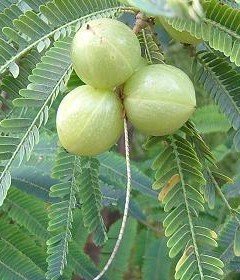Indian Gooseberry
Botanical Name: Emblica officinalis
Indian name: Indian Gooseberry
Indian Name: Amla
Origin, Distribution and Composition
Indian gooseberry is a small or middle-sized deciduous tree. It has small, very closely set, 10 to 13 mm long, leaves. The branches of the tree appear feathery. The tree has pale green flowers usually in small dense dusters below the leaves.
The fruits are fleshy, round with its contour indistinctly marked into 6 lobes, about 1.5 to 2.5 cms in diameter and, pale green or yellowish in colour. The fruit has a seed inside with three angles and three sides.
The herb has been used as a valuable ingredient of various medicines in India and the Middle East from time immemorial.

Nutritional and Healing Power of Indian Gooseberry
As the name suggests the herb is indigenous to India. An analysis shows that it contains on an average, moisture 81.8 per cent, protein 0.5 per cent, fat 0.1 per cent, minerals 0.5 per cent, fibre 3.4 per cent and carbohydrates 13.7 per cent, per 100 grams of edible portion.
Its mineral and vitamin contents include calcium, phosphorus, iron, carotene, thiamine, riboflavin, niacin and vitamin C.
It is valued chiefly for its high vitamin C content. Repeated laboratory tests show that every 100 grams of fresh fruit provides 470 to 680 mg of vitamin C. The vitamin C value increases further when the juice is extracted from the fruit. The dehydrated berry provides 2428 to 3470 mg of vitamin C per 100 grams.
Even when it is dried in shade and turned into powder, it retains as much as 1780 to 2660 mg of vitamin C. The seeds of the Indian gooseberry contain a phosphatides and an essential oil. The fruits, bark and the leaves of the tree are rich in tannin.
It is a wonder herb and one of the precious gifts of nature to man. It contributes greatly towards health and longevity.
Ayurvedic physicians use this herb very commonly in their medicines and regard it as a medicine for heart and other health problems. They also advise its external application due to its cool and astringent properties.
The fruit is acrid, cooling, refreshing and laxative. It increases the volume of urine. The raw fruit is a mild purgative. The flowers of the tree are cooling refreshing and mild purgative. The root and bark of the tree are useful in arresting secretion or bleeding.
A tablespoon each of fresh gooseberry juice and honey mixed together is a very valuable medicine for the treatment of several ailments. Its regular use every morning promotes vigour in the body within a few days. When fresh fruit is not available, dry powder can be mixed with honey.
Respiratory Disorders
The herb is beneficial in the treatment of respiratory disorders. It is especially valuable in tuberculosis of the lungs, asthma and bronchitis.
Diabetes
This herb, due to its high vitamin C content, is effective in controlling diabetes. A tablespoon of its juice, mixed with a cup of fresh bitter-gourd juice, taken daily for two months will stimulate the pancreas and enable it to secrete insulin, thus reducing the blood sugar in diabetes.
Diet restrictions should be strictly observed while taking this medicine. It will also prevent eye complications in diabetes.
Equal quantities of powdered herb, jambul fruit and bitter-gourd provide a very useful remedy for diabetes. A tablespoon of this mixture once or twice a day would be effective in checking the progress of the disease.
Heart Disorders
Indian gooseberry is considered an effective remedy for heart disease. It tones up the functions of all the organs of the body and builds up health by destroying the harmful and disease causing elements. It also renews energy.
Eye Disorders
The juice of gooseberry with honey is useful in preserving eye sight. It is beneficial in the treatment of conjunctivitis and glaucoma. It reduces intraocular tension in a remarkable manner. A cup of this juice mixed with honey can be taken twice daily for this condition.
Rheumatism
To treat rheumatism, a teaspoon of the powder of the dry fruit mixed with 2 teaspoons of jaggery can be taken twice daily for a month.
Scurvy
As an extremely rich source of vitamin C, Indian gooseberry is one of the best remedies for scurvy. Powder of the dry herb, mixed with an equal quantity of sugar, can be taken in doses of one teaspoon, thrice daily with milk.
Diarrhoea and Dysentery
The dried fruit is also useful m diarrhoea and dysentery. A drink made from the herb, mixed with lemon juice and sugar controls acute bacillary dysentery.
One tablespoon of the paste of leaves, mixed with honey or buttermilk, can be taken for treating the condition.
Ageing
It has revitalising effects, as it contains an element which is very valuable in preventing ageing and in maintaining strength in old age.
It improves body resistance and protects the body against infection. It strengthens the heart, hair and different glands in the body.
hair tonic
Hair Tonic: Indian gooseberry is an accepted hair tonic in traditional recipes for enriching hair growth and pigmentation. The fruit, cut into pieces, is dried, preferably in the shade.
These pieces are boiled in coconut oil till the solid matter becomes charred. This oil is excellent in preventing greying.
The water in which dried gooseberry pieces are soaked overnight is also nourishing to hair and can be used for the last rinse while washing the hair.
Other Uses
Indian gooseberry is used in various ways. The best way to take it with the least loss of vitamin C, is to eat it raw with a little salt. It is often used in the form of jams and marmalade.
It can be preserved for a long period when it is dried and powdered. The berry may also be used as a vegetable. It is boiled in a small amount of water till soft and taken with a little salt.



